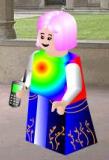 By way of gaining a bit of background knowledge of the Renaissance before the course starts, I've commenced reading this book written by the art historian Andrew Graham-Dixon. It was written to accompany a series of BBC TV programmes. I hope to add some notes and quotes as I go along in an effort to reinforce reading and maybe possibly remember some of it!
By way of gaining a bit of background knowledge of the Renaissance before the course starts, I've commenced reading this book written by the art historian Andrew Graham-Dixon. It was written to accompany a series of BBC TV programmes. I hope to add some notes and quotes as I go along in an effort to reinforce reading and maybe possibly remember some of it!Chapter One: In Search of Origins.
Notes: The Renaissance is not a simple straight forward event or 'rebirth' but is the point at which many strands and ideas from different cultures mee
 t and combine in new and exploratory ways. 'a harmony of many parts' (p.57). The Renaissance is not just about the awakening to classical ideas in Northern Italy but is also the result of changes in the perception of Christianity presenting the human Christ instead of the 'Christ Pantocrator'*, the expression of naturalism, and the development of oil painting in Northern Europe and the continuing influence of Byzantine religious art, which itself traces its roots back to Egypt and even the Pharoahs.
t and combine in new and exploratory ways. 'a harmony of many parts' (p.57). The Renaissance is not just about the awakening to classical ideas in Northern Italy but is also the result of changes in the perception of Christianity presenting the human Christ instead of the 'Christ Pantocrator'*, the expression of naturalism, and the development of oil painting in Northern Europe and the continuing influence of Byzantine religious art, which itself traces its roots back to Egypt and even the Pharoahs.*Christ represented triumphant, all powerful and dauntless, the master of human destiny as seen in the basilica, San Marco, Venice c. 1270
Quotes: The Roman Road - 'The way back to those [Renaissance] origins is no straight Roman Road, leading directly to the classical past, but a more winding and circuitous route'. (p.11)

Art Bleeds - 'During the thirteenth century, however, a dramatic change came over art on the Italian peninsula. Instead of depicting Christ the king, artists began to depict Christ the man, bloodied and suffering. Painting and sculpture were altered for ever. A single charismatic individual was largely responsible for bringing Christ down to earth, and for effecting this change - not an artist, but a man sometimes referred to by his followers as alter Christus, 'another Christ'. He was St Francis of Assisi'. (p.16)
'The Franciscan faith did not only revolutionise the image of Christ, it also gave an entirely new status and urgency to narrative art'. (p.24)


Right: Artist Unknown Christus Triumphans (Christ Triumphant on the Cross), late 12th century.
Left: Coppo Di Marcovaldo Christus Patiens(Christ Suffering on the Cross) c.1250-55
(click on picture to see enlarged)
Duccio - 'Two visual languages, the naturalistic and the transcendent, so to speak, could enrich and compliment each other'. (p.43)
'...a crowd of the real in a space that is ideal'(p.44)
'His clothes [Christ] have been highlighted in gold in the old Italio-Byzantine trechnique of chrysography, an effect which removes him somewhat from the world occupied by the other figures in the painting' (p.45, illustration 19, The Transfiguration, in the National Gallery, London link ).
'Divinity is communicated by design' (p.45)

2 comments:
Fascinating stuff! I can't make any clever art-historical comments, but I'm enjoying your voyage of discovery :-)
Is it significant that Christ looks serene on the first & tormented on the second image (just above the Duccio)? Wasn't sure if they count as the same era or showing the transition from earier (pantocrator) to later (human).
Hi Lynne, Thanks for your interest! Yes it is very significant, the change in the look of the crucified Christ. You have hit it on the head, they most certainly do show this transition!
Post a Comment